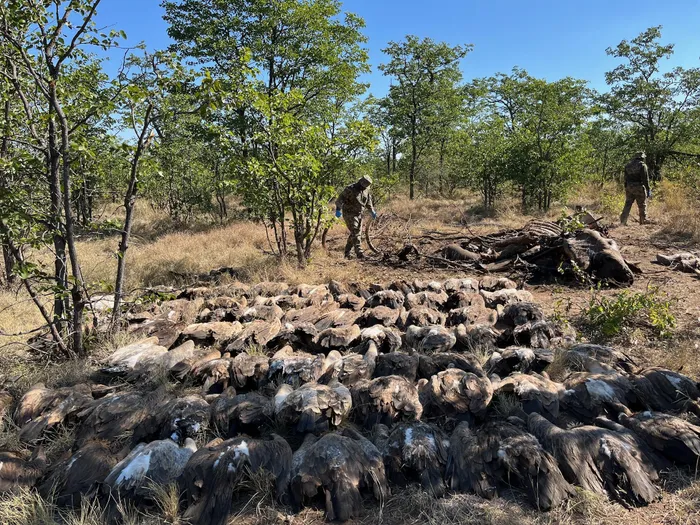Mass poisoning of vultures in Kruger National Park: 123 dead
crime

More than 100 vultures, all endangered, died in a mass poisoning in the Kruger National Park.
Image: Supplied.
More than 100 vultures have died in a mass poisoning in the Kruger National Park, one of the largest such incidents recorded in Southern Africa.
The discovery was made early Thursday in the Mahlangeni section of the park, after the Endangered Wildlife Trust’s (EWT) poisoning detection system triggered an alert at 6.05am, flagging suspicious activity in a remote area. A joint SANParks and EWT team was mobilised and arrived at the scene about two hours later.
Eleanor Momberg the EWT’s communications manager said it was one of the largest poisonings seen at the park.
“There they discovered the grim reality; a mass poisoning event involving hundreds of vultures, the result of an elephant carcass laced with highly toxic agrochemical pesticides - poison laid by poachers to harvest body parts for the illegal wildlife trade.”
Momberg said the initial responders found two vultures who were severely affected about 500 metres from the poisoned elephant carcass. These vultures were treated using emergency vulture first aid which consists of atropine, activated charcoal and fluid therapy.“
Reinforcements were swiftly deployed."
In total, 116 vultures were initially found dead at the scene and a further 84 were rescued. What followed, she said, was a co-ordinated, high-intensity rescue effort.
"Support teams from the Moholoholo Wildlife Rehabilitation Centre, Briner Veterinary Services and Wildscapes Veterinary Services mobilised within hours, while SANParks activated ranger and aerial support - including the Hope for Wildlife helicopter and additional logistics support - making this the first time SANParks helicopters were formally used in a wildlife poisoning rescue of this scale,” she said.
Of the 84 rescued birds - comprising White-backed, Cape, and Hooded Vultures - 45 were transported via EWT’s specialised “vulture ambulance", while 39 were airlifted to the SANParks K9 facility in Phalaborwa for monitoring.
A final group was transported to Moholoholo for continued intensive care late on Thursday night where teams worked round the clock to stabilise the birds and keep them alive. “Despite the best efforts, five vultures succumbed to poisoning. However, a remarkable 96% survival rate was achieved among those found alive,” said Momberg. This morning 83 vultures were still alive and recovering.
She described the scale of the tragedy as “staggering” with the final tally of dead birds found at the Park rising to 123. Of that, 102 were White-backed vultures, 20 Cape vultures, and one Lappet-faced vulture. All these birds are listed as endangered or critically endangered species.
“This marks one of the largest vulture poisoning event in Southern Africa - and the most extensive co-ordinated response effort and rescue to date. Over 20 individuals across conservation, veterinary, and enforcement sectors played a role in the rescue and response. Without rapid detection by the EWT’s wildlife poisoning detection and surveillance system and the unprecedented co-operation between NGOs, rangers, vets, and SANParks aerial and ranger units, many more birds would have been lost,” Momberg added. She said the incident highlighted the broader crisis unfolding across southern Africa which was the use of poisons in wildlife poaching.
“Poachers increasingly use agricultural toxins to target high-value species - not just vultures, but also lions, whose body parts are in growing demand for traditional medicine or muthi.
“This incident is a setback to the vulture population in the greater Kruger landscape, which is trying to recover from similar incidents in the past. "SANParks and various agencies and institutions are collaborating to address the current increase in incidents."
EWT said that the operation highlighted the importance of partnerships in addressing this problem. “The recovery and treatment of the live vultures would not have been possible if such partnerships were not in place. We commend every individual who responded to this tragedy. Their courage, skill, and relentless commitment transformed a potential extinction-level event into one of the most successful vulture rescues ever recorded.”